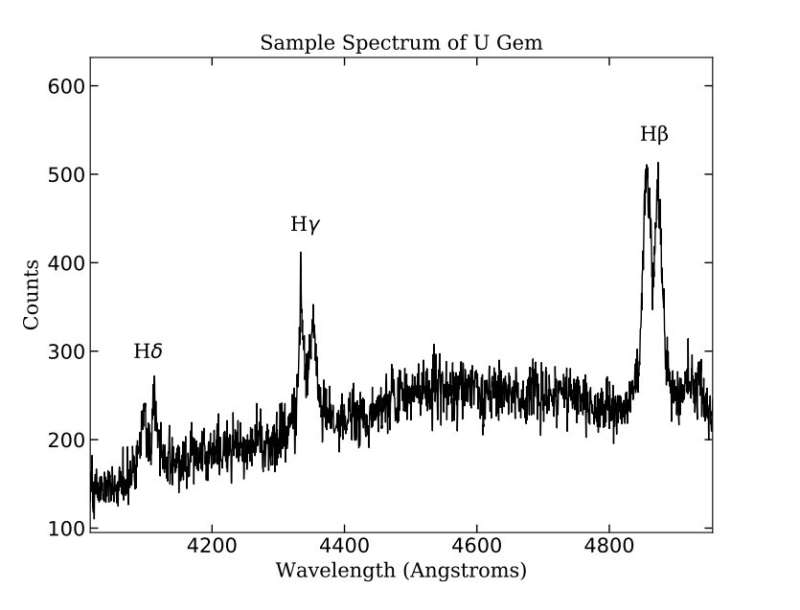March 20, 2023 report
This article has been reviewed according to Science X's editorial process and policies. Editors have highlighted the following attributes while ensuring the content's credibility:
fact-checked
preprint
trusted source
proofread
New spectroscopic observations of dwarf nova U Geminorum unveil its properties

Using the Guillermo Haro Observatory (OAGH) in Mexico, astronomers have performed spectroscopic observations of a dwarf nova known as U Geminorum. Results of the observational campaign, published March 10 on the arXiv pre-print repository, yield important insights into the properties of this object.
Cataclysmic variables (CVs) are binary star systems consisting of a white dwarf primary accreting matter from a normal star companion. They irregularly increase in brightness by a large factor, then drop back down to a quiescent state. These binaries have been found in many environments, such as the center of the Milky Way galaxy, the solar neighborhood, and within open and globular clusters.
Given that in CVs, mass transfer from the companion star often occurs through an accretion disk around the white dwarf and in some cases thermal instability in the disk triggers an outburst known as a dwarf nova (DN). These novae are a type of CVs that undergo semi-periodic outbursts. Some DNe only experience regular 2–5 mag outbursts (U Gem type) while others display additional features.
Located some 304.5 light years away in the constellation Gemini, U Geminorum (U Gem for short) is the prototype of U Gem DNe, discovered in 1855. The system, consisting of a white dwarf and a red dwarf companion, has an orbital period of approximately 0.177 days, a mass ratio 0.35, and outburst recurrence of about 118 days.
U Gem is one of the best studied DNe and previous observations have found that it showcases behavior far more complicated than that predicted in the classical model. For instance, U Gem has been observed to exhibit diverse emission structures in quiescence: from that of an extended disk dominated by the emission from the hot spot, to a highly asymmetric shape similar to spiral arms overlaying the disk.
That is why a team of astronomers led by Juan Echevarria of the National Autonomous University of Mexico, decided to conduct spectroscopic observations of U Gem with OAGH's 2.1-m telescope.
The new observations found that the white dwarf in U Gem has a mass between 1.2 and 1.38 solar masses. The mass of the red dwarf is estimated to be within the range of 0.42–0.61 solar masses. Therefore, the mass ratio of the system was calculated to be between 0.34 and 0.44.
The study also found that U Gem does not showcase a typical disk and there is no evidence of a hotspot. The researchers noted that the system instead exhibits a spiral arm structure unexpected of a system in quiescence. They explain that such unusual shape could be a result of white dwarf irradiation of tidally thickened regions, a stream overflow, a partially truncated disk, or even due to fully formed spiral arms.
The authors of the paper added that further observations of U Gem are required in order to fully understand the peculiar nature of this system.
"U Gem stands as one of the best studied DN, however as it is made evident in this paper, more ingredients than those prescribed by the classical model must come into play to better explain its behavior. Therefore, we propose further observations of this source to help shed light on the mechanisms giving rise to its rich and interesting nature," the scientists concluded.
More information: J. Echevarría et al, New Spectroscopy of U Gem, arXiv (2023). DOI: 10.48550/arxiv.2303.05625
Journal information: arXiv
© 2023 Science X Network





















